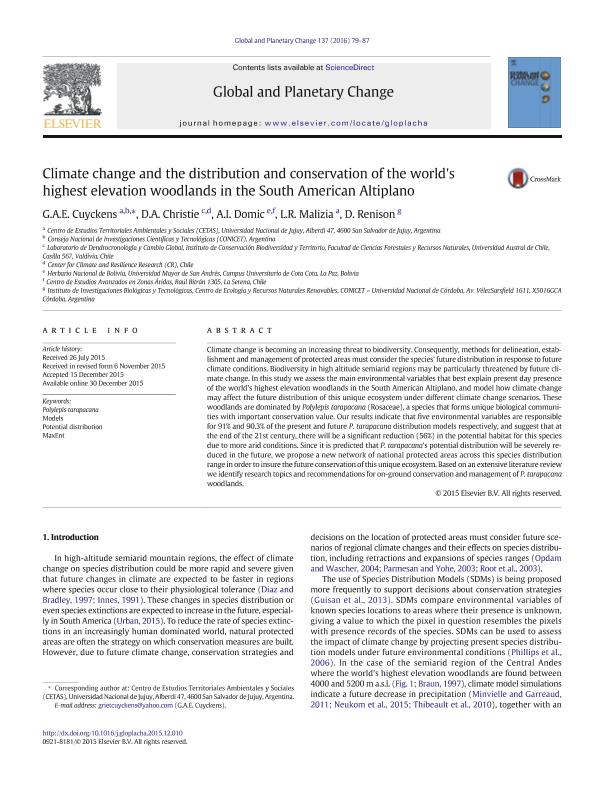Mostrar el registro sencillo del ítem
dc.contributor.author
Cuyckens, Griet An Erica

dc.contributor.author
Christie, D. A.
dc.contributor.author
Domic, A. I.
dc.contributor.author
Malizia, Lucio Ricardo

dc.contributor.author
Renison, Daniel

dc.date.available
2018-03-23T17:54:11Z
dc.date.issued
2016-02
dc.identifier.citation
Cuyckens, Griet An Erica; Christie, D. A.; Domic, A. I.; Malizia, Lucio Ricardo; Renison, Daniel; Climate change and the distribution and conservation of the world's highest elevation woodlands in the South American Altiplano; Elsevier Science; Global and Planetary Change; 137; 2-2016; 79-87
dc.identifier.issn
0921-8181
dc.identifier.uri
http://hdl.handle.net/11336/39804
dc.description.abstract
Climate change is becoming an increasing threat to biodiversity. Consequently, methods for delineation, establishment and management of protected areas must consider the species' future distribution in response to future climate conditions. Biodiversity in high altitude semiarid regions may be particularly threatened by future climate change. In this study we assess the main environmental variables that best explain present day presence of the world's highest elevation woodlands in the South American Altiplano, and model how climate change may affect the future distribution of this unique ecosystem under different climate change scenarios. These woodlands are dominated by Polylepis tarapacana (Rosaceae), a species that forms unique biological communities with important conservation value. Our results indicate that five environmental variables are responsible for 91% and 90.3% of the present and future P. tarapacana distribution models respectively, and suggest that at the end of the 21st century, there will be a significant reduction (56%) in the potential habitat for this species due to more arid conditions. Since it is predicted that P. tarapacana's potential distribution will be severely reduced in the future, we propose a new network of national protected areas across this species distribution range in order to insure the future conservation of this unique ecosystem. Based on an extensive literature review we identify research topics and recommendations for on-ground conservation and management of P. tarapacana woodlands.
dc.format
application/pdf
dc.language.iso
eng
dc.publisher
Elsevier Science

dc.rights
info:eu-repo/semantics/openAccess
dc.rights.uri
https://creativecommons.org/licenses/by-nc-sa/2.5/ar/
dc.subject
Maxent
dc.subject
Models
dc.subject
Polylepis Tarapacana
dc.subject
Potential Distribution
dc.subject.classification
Otras Ciencias Biológicas

dc.subject.classification
Ciencias Biológicas

dc.subject.classification
CIENCIAS NATURALES Y EXACTAS

dc.title
Climate change and the distribution and conservation of the world's highest elevation woodlands in the South American Altiplano
dc.type
info:eu-repo/semantics/article
dc.type
info:ar-repo/semantics/artículo
dc.type
info:eu-repo/semantics/publishedVersion
dc.date.updated
2018-03-21T16:28:44Z
dc.journal.volume
137
dc.journal.pagination
79-87
dc.journal.pais
Países Bajos

dc.journal.ciudad
Amsterdam
dc.description.fil
Fil: Cuyckens, Griet An Erica. Consejo Nacional de Investigaciones Científicas y Técnicas; Argentina. Universidad Nacional de Jujuy. Facultad de Ciencias Agrarias. Centro de Estudios Ambientales Territoriales y Sociales; Argentina
dc.description.fil
Fil: Christie, D. A.. Universidad Austral de Chile; Chile. Center for Climate and Resilience Research; Chile
dc.description.fil
Fil: Domic, A. I.. Universidad Mayor de San Andrés; Bolivia. Centro de Estudios Avanzados en Zonas Árida; Chile
dc.description.fil
Fil: Malizia, Lucio Ricardo. Universidad Nacional de Jujuy. Facultad de Ciencias Agrarias. Centro de Estudios Ambientales Territoriales y Sociales; Argentina
dc.description.fil
Fil: Renison, Daniel. Consejo Nacional de Investigaciones Científicas y Técnicas. Centro Científico Tecnológico Conicet - Córdoba. Instituto de Investigaciones Biológicas y Tecnológicas. Universidad Nacional de Córdoba. Facultad de Ciencias Exactas, Físicas y Naturales. Instituto de Investigaciones Biológicas y Tecnológicas; Argentina
dc.journal.title
Global and Planetary Change

dc.relation.alternativeid
info:eu-repo/semantics/altIdentifier/doi/http://dx.doi.org/10.1016/j.gloplacha.2015.12.010
dc.relation.alternativeid
info:eu-repo/semantics/altIdentifier/url/https://www.sciencedirect.com/science/article/pii/S0921818115301600
Archivos asociados
